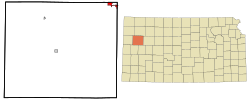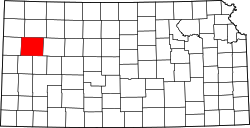2020 census
The 2020 United States census counted 2,046 people, 896 households, and 540 families in Oakley. [11] [12] The population density was 1,064.0 per square mile (410.8/km2). There were 1,006 housing units at an average density of 523.1 per square mile (202.0/km2). [12] [13] The racial makeup was 89.98% (1,841) white or European American (87.78% non-Hispanic white), 0.1% (2) black or African-American, 0.05% (1) Native American or Alaska Native, 0.54% (11) Asian, 0.1% (2) Pacific Islander or Native Hawaiian, 3.86% (79) from other races, and 5.38% (110) from two or more races. [14] Hispanic or Latino of any race was 8.31% (170) of the population. [15]
Of the 896 households, 29.1% had children under the age of 18; 48.8% were married couples living together; 26.5% had a female householder with no spouse or partner present. 34.4% of households consisted of individuals and 16.3% had someone living alone who was 65 years of age or older. [12] The average household size was 2.3 and the average family size was 2.9. [16] The percent of those with a bachelor’s degree or higher was estimated to be 11.8% of the population. [17]
24.5% of the population was under the age of 18, 6.3% from 18 to 24, 24.8% from 25 to 44, 23.6% from 45 to 64, and 20.8% who were 65 years of age or older. The median age was 40.1 years. For every 100 females, there were 101.4 males. [12] For every 100 females ages 18 and older, there were 104.5 males. [12]
The 2016-2020 5-year American Community Survey estimates show that the median household income was $46,042 (with a margin of error of +/- $7,884) and the median family income was $60,179 (+/- $13,943). [18] Males had a median income of $35,641 (+/- $5,149) versus $21,122 (+/- $4,807) for females. The median income for those above 16 years old was $26,514 (+/- $3,763). [19] Approximately, 6.5% of families and 11.4% of the population were below the poverty line, including 18.2% of those under the age of 18 and 3.8% of those ages 65 or over. [20] [21]
2010 census
As of the census [22] of 2010, there were 2,045 people, 920 households, and 562 families residing in the city. The population density was 1,054.1 inhabitants per square mile (407.0/km2). There were 1,035 housing units at an average density of 533.5 per square mile (206.0/km2). The racial makeup of the city was 96.6% White, 0.4% African American, 0.6% Native American, 0.4% Asian, 0.7% from other races, and 1.4% from two or more races. Hispanic or Latino of any race were 2.8% of the population.
There were 920 households, of which 25.9% had children under the age of 18 living with them, 49.9% were married couples living together, 7.6% had a female householder with no husband present, 3.6% had a male householder with no wife present, and 38.9% were non-families. 35.0% of all households were made up of individuals, and 16.7% had someone living alone who was 65 years of age or older. The average household size was 2.18 and the average family size was 2.78.
The median age in the city was 44.8 years. 22.1% of residents were under the age of 18; 6.3% were between the ages of 18 and 24; 21.8% were from 25 to 44; 27.3% were from 45 to 64; and 22.6% were 65 years of age or older. The gender makeup of the city was 48.0% male and 52.0% female.





